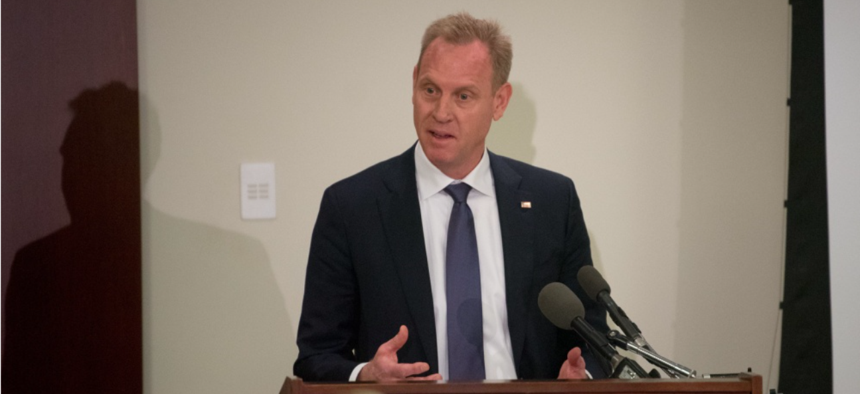
U.S. Deputy Secretary of Defense Patrick M. Shanahan speaks to members of the Military Reporters and Editors Association during their annual convention at the Navy League Building in Arlington, Va., Oct. 26, 2018. Department of Defense/Sgt. Amber Smith
Will Trump Really Cut Defense Spending by 5%? It’s Way Too Early To Say
The Pentagon’s No. 2 confirms that the president’s surprise order will affect the military, but experts say there may ultimately be no decline at all.
The U.S. military will indeed be affected by a 5 percent cut in federal spending ordered by President Trump at a cabinet meeting last week, Deputy Defense Secretary Patrick Shanahan said Friday.
“We will do as directed by the president and give him a $700 billion budget and then everybody gets to decide how to work with that,” Shanahan said Friday at the Military Reporters and Editors Conference in Arlington, Virginia.
Since that $700 billion includes the Energy Department’s nuclear funding, as is customary, it heralds a dip from 2019’s budget of $716 billion and a planned $733 billion for 2020. But defense budget experts put little stock in that number, which they called just an opening salvo in the battle over the next budget.
“I don’t even take this number seriously — it’s meaningless,” said Gordon Adams, who ran defense budgeting at the Office of Management and Budget during the Clinton administration. “It’s an opening shot in the game.”
Between now and December, Pentagon officials will negotiate with White House budget officials about the size of the defense budget proposal, which is usually sent to Congress in early February.
“The White House may be saying that” — $700 billion — “but I’ll tell you from history, I’ve lived through a lot of White Houses that folded in December,” Adams said. “They had a tough position going in and at some point the Pentagon marshaled its political forces and went and had a conversation with the [president] and in the end it wasn’t what the original proposal was.”
Indeed, Shanahan said DoD planners would continue work on their $733 billion budget, even as they began to work up a $700 billion version.
“We are not going to reverse course on all of that planning,” said Shanahan, alluding to the months of work already completed by military budgeteers. The two budgets will give Defense Secretary Jim Mattis “a clear understanding of what the tradeoffs are,” he said.
Shanahan’s acknowledgement of the dueling budget proposals signals “that this is not necessarily a done deal,” said Todd Harrison, a defense budget analyst with the Center for Strategic and International Studies. “Mattis could still go back to the president and say: ‘Here’s the $700 billion budget, I can’t execute the [National Defense] Strategy, I can’t fund things that are important to your priorities. Can I get the $733 billion?’”
Said Adams: “Ultimately, the defense topline has always been a decision between the secretary of defense and the president of the United States. The rest of it is the preliminaries.”
Shanahan said he had spoken about the cuts with Mick Mulvaney, the White House Office of Management and Budget director. The Defense Department’s No. 2 civilian leader characterized that telephone conversation as: “Here’s the assignment. Let’s get to work on it.”
Many parts of the Defense Department’s 2020 spending plan are already locked in, such as service members’ pay and benefits. Any budget cuts will likely fall on weapons procurement and research-and-development initiatives.
Shanahan mentioned hypersonic missiles, which are among the Pentagon’s top R&D priorities: “These projects, we can choose either to do them or to defer them.”
Beyond the Pentagon-White House battle, the 2020 defense budget faces several political wild cards. For one, federal spending caps, sometimes called sequestration, are set to return in 2020 and 2021, unless Congress passes legislation to remove them.
Next month’s midterm elections will also shape federal spending.
“If the Democrats take the House … then what we can foresee is a mighty negotiation over a very long period of time between the White House, the Republicans in the Senate and the Democrats, if they win the House,” Adams said.
Republicans have historically tried to offset defense spending increases by cuts to other domestic spending, such as social security programs. Democrats have been open to defense spending increases as long as domestic spending gets an equal boost.
If the Democrats win the House, “what we enter then is not the politics of defense, we enter the politics of the budget,” Adams said. “It’s not longer a ‘what’s the right number for defense’ game, it is ‘what will defense get relative to other things’.”



